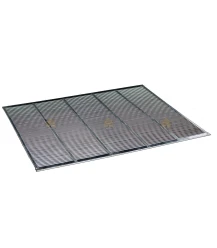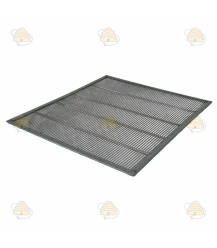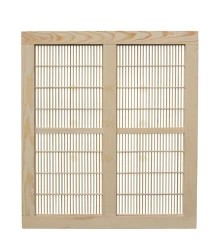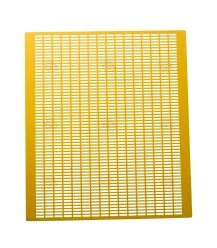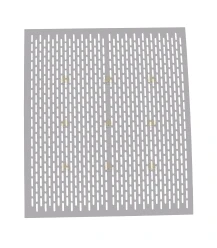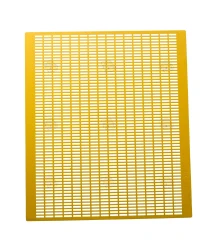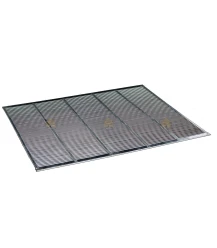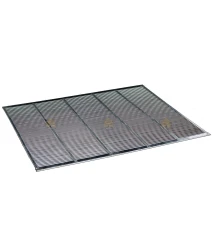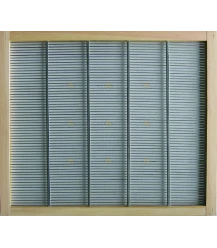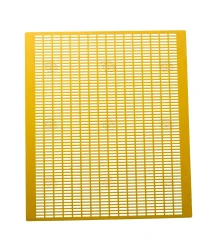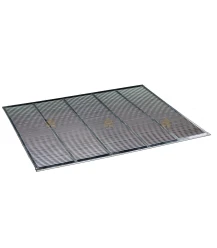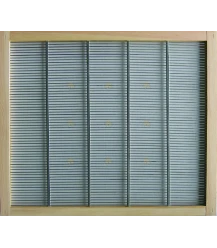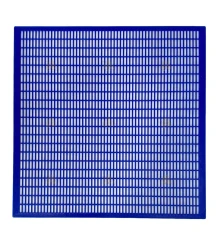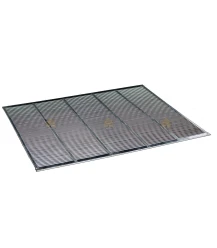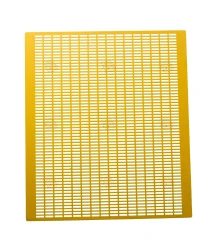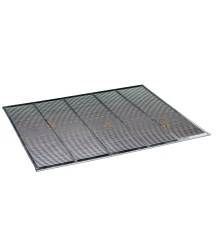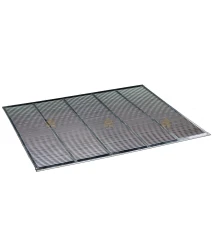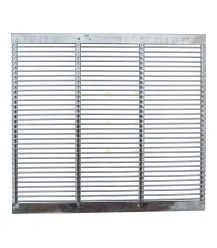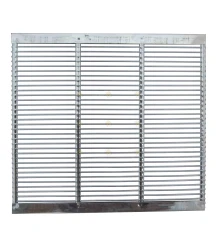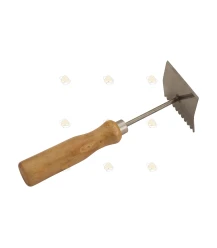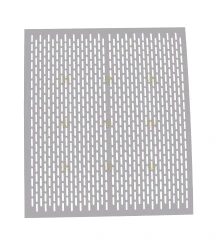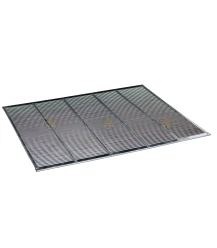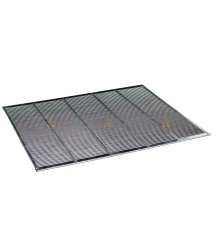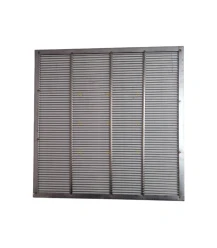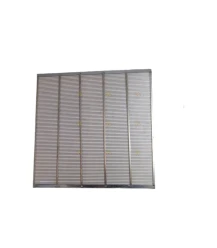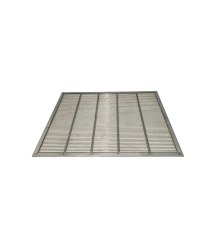Queen excluders for beehives
A queen excluder, also called a moerrooster, is a grid that the queen cannot pass through. This lets you manage the bee colony. For example, you can use it to prevent a queen from entering the honey super. This way the queen lays no eggs in the honey super and the honey from the colony you can harvest. But by using a queen excluder you can also force the queen to stay in a specific part of the hive. If, for example, you want to remove the lower brood box to clean it or carry out comb renewal, you can use a queen excluder. This ensures the queen remains in the upper brood box. Usually you can encourage her to move up by blowing smoke with a smoker into the entrance. You can then place the queen excluder on the lower box. Then put the upper box back on. If all goes well, this will prevent the queen from entering the lower box. After a few days, check whether there are eggs in the lower box. If not, the queen is above the excluder, in the upper brood box. Once all brood has emerged in the lower box, you can remove it and/or replace the comb.
-
Spaarkast queen excluder galvanized 47,2 x 42,1 cm
€ 8,45 In stock and available for immediate delivery.Queen excluder made of heavy-duty galvanized steel for the spaarkast. Dimensions: 471 x 421 mm, 3 mm thick. The queen excluder allows the bees to access the honey super, but not the queen. This excluder sits between the brood box and the honey super and fits the spaarkast perfectly. The excluder scraper for this metal queen excluder can be found [product...View more -
spaarkast 4-sided metal-bound queen excluder galvanized 47,2 x 42,2 cm
€ 11,95 In stock and available for immediate delivery.Spaarkast queen excluder, made of galvanized steel and fitted with a galvanized frame around the entire outer edge.Dimensions: 47.2 x 42.2 cm and about 5 mm thick. (Very sturdy.) The queen excluder allows worker bees to reach the honey super, but keeps the queen out. This excluder sits between the brood box and the honey super and fits the Spaarkast...View more -
spaarkast 4-sided stainless steel framed queen excluder 47.2 x 42.1 cm
€ 20,95 In stock and available for immediate delivery.spaarkast queen excluder, made of stainless steel (RVS) and fitted with a stainless-steel frame around the entire outer edge. Dimensions: 47.2 x 42.2 cm and about 5 mm thick. (Very sturdy.) The queen excluder allows the bees to access the honey super, but not the queen. This excluder sits between the brood box and the honey super and fits the spaarkast...View more -
Spaarkast queen excluder wood 47.2 x 42.1 cm
€ 9,99 In stock and available for immediate delivery.Queen excluder with a wooden frame and wooden slats. Ideal if you want to work only with the most natural materials. The dimensions of the wooden queen excluder are: 471 x 421 mm, .... mm thick. The queen excluder ensures that the bees can move up to the honey super, while the queen cannot. This excluder sits between the brood box and the honey super and...View more -
Spaarkast framed queen excluder wood/galvanized 47,2 x 42,1 cm
€ 13,95 In stock and available for immediate delivery.Queen excluder in wood and metal, framed for the spaarkast with dimensions 42.1 x 47.2 with 15 mm wooden frame. The queen excluder ensures that the bees can access the honey super but the queen cannot. This excluder sits between the brood box and the honey super. You can find the queen excluder scraper for this queen excluder [product id=411]here[/product].View more -
Spaarkast queen excluder PVC 47 x 41 cm
€ 5,25 In stock and available for immediate delivery.Plastic queen excluder for the spaarkast with dimensions 47 x 41 cm. The queen excluder allows the bees to move into the honey super, but not the queen. This excluder sits between the brood box and the honey super.You can find the queen excluder scraper for this queen excluder [product id=411]here[/product].View more -
Spaarkast queen excluder perforated aluminum 47 x 42 cm
€ 10,95 In stock and available for immediate delivery.Aluminum perforated queen excluder for the spaarkast, 47 x 42 cm. The queen excluder allows the bees to access the honey super but not the queen. This excluder sits between the brood box and the honey super. Also available in other materials and sizes.View more -
Queen excluder scraper PVC
€ 10,35 Out of stockOut of stockPlastic scraper for cleaning queen excluders. With this scraper you can easily clean off beeswax and propolis that has stuck to the excluder. Note: only suitable for all sizes of metal queen excluders and for the plastic [product id=406]queen excluders size 50 x 43[/product].View more -
Segeberger queen excluder galvanized 43,5 x 43,5 cm
€ 8,50 In stock and available for immediate delivery.Metal (galvanized) queen excluder for the Segeberger hive, size 43.5 x 43.5 cm. The queen excluder ensures that the bees can access the honey super, but the queen cannot. This excluder sits between the brood box (brood chamber) and the honey super.View more -
Segeberger queen excluder galvanized 38 x 38 cm
€ 9,85 In stock and available for immediate delivery.Queen excluder made of metal (galvanized), measuring 38 x 38 cm. The excluder is approximately 3 mm thick. The queen excluder allows the bees into the honey super, but not the queen. This queen excluder fits perfectly in the [product id=842]Segeberge[/product]r intermediate floor. This excluder sits between the brood box and the honey super.The queen...View more -
Segeberger queen excluder PVC 43,5 x 43,5 cm
€ 5,25 In stock and available for immediate delivery.Plastic queen excluder for the Segeberger hive measuring 43.5 x 43.5 cm. The queen excluder allows the bees to access the honey super, but not the queen. This excluder sits between the brood box and the honey super.View more -
Spaarkast polystyrene / Simplex BE queen excluder galvanized 46 x 46 cm
€ 8,75 In stock and available for immediate delivery.Metal queen excluder measuring 46 x 46 cm x 3 mm for the polystyrene BeeFun beehive and the Belgian simplex beehive. The queen excluder allows the bees into the honey super but keeps the queen out. This excluder sits between the brood box and the honey super. Also available in other materials and sizes. The queen excluder scraper for this queen excluder...View more -
simplex BE queen excluder galvanized 45 x 45 cm
€ 9,30 In stock and available for immediate delivery.Metal queen excluder, 45 x 45 cm. The excluder is approximately 3 mm thick. The queen excluder allows the bees into the honey super, but not the queen. This excluder sits between the brood box and honey super.You can find the scraper for this queen excluder [product id=411]here[/product].View more -
polystyrene spaarkast / simplex BE framed queen excluder wood/galvanised 46 x 46 cm
€ 15,25 In stock and available for immediate delivery.Metal queen excluder with wooden frame 46 x 46 for the Belgian simplex hive and the BeeFun polystyrene spaarkast. The queen excluder allows bees into the honey super but keeps the queen out. This excluder sits between brood box and honey super.You can find the queen excluder scraper for this queen excluder [product id=411]here[/product].View more -
spaarkast polystyrene / simplex BE queen excluder PVC 46 x 46 cm
€ 5,45 In stock and available for immediate delivery.Queen excluder made of PVC for the polystyrene BeeFun beehives and the Belgian simplex beehive. This plastic excluder measures 46 x 46 cm. The queen excluder lets the bees move into the honey super while keeping the queen out. This excluder sits between the brood box and the honey super. Also available in other materials and sizes. You can find the queen...View more -
spaarkast polystyrene / simplex BE queen excluder perforated aluminium 46 x 46 cm
€ 10,95 In stock and available for immediate delivery.Queen excluder in perforated aluminum for polystyrene BeeFun hives and the Belgian simplex hive. The size of this excluder is 46 x 46 cm. The queen excluder ensures that the bees can reach the honey super but the queen cannot. This excluder sits between the brood box and the honey super. Also available in other materials and sizes.View more -
Dadant queen excluder galvanized 50 x 50 cm
€ 12,05 In stock and available for immediate delivery.Metal queen excluder for the Dadant hive, measuring 50 x 50 cm. The queen excluder allows bees to enter the honey super but not the queen. This excluder sits between the brood box and the honey super.View more -
Dadant Blatt queen excluder galvanized 50 x 43 cm
€ 9,30 In stock and available for immediate delivery.Metal queen excluder for beehives (including Dadant Blatt) measuring 50 x 43 cm. The excluder is about 3 mm thick. The queen excluder lets the bees reach the honey super, but not the queen. This excluder sits between the brood box and the honey super.The queen excluder scraper for this queen excluder can be found [product id=411]here[/product].View more -
Dadant US framed queen excluder wood/galvanized steel 50 x 50 cm
€ 15,15 In stock and available for immediate delivery.Wood-and-metal queen excluder in Dadant US size. Dimensions are 50 x 50 with 15 mm wooden frame. The queen excluder allows bees into the honey super but not the queen. This excluder sits between the brood box and honey super.The excluder scraper for this queen excluder can be found [product id=411]here[/product].View more -
Dadant drone excluder PVC 50 x 50 cm
€ 9,85 This product is in stock.Drone excluder made of blue PVC for Dadant, measuring 50 x 50 cm. The drone excluder ensures that the worker bees and the queen can pass through the grid, but the drones cannot. As a result, no mating takes place in the area of the hive screened off with this excluder.View more -
Dadant queen excluder PVC 50 x 50 cm
€ 5,25 In stock and available for immediate delivery.PVC queen excluder for Dadant, measuring 50 x 50 cm. The queen excluder ensures that the bees can reach the honey super but the queen cannot. This excluder sits between the brood box (brood chamber) and the honey super.View more -
queen excluder galvanized 45 x 40 cm
€ 9,85 In stock and available for immediate delivery.Metal queen excluder, 45 x 40 cm, 3 mm thick. The queen excluder allows the bees to access the honey super while keeping the queen out. This excluder sits between the brood box and the honey super.The scraper for this queen excluder can be found [product id=411]here[/product].View more -
simplex galvanized queen excluder 43 x 38 cm
€ 8,95 In stock and available for immediate delivery.Metal queen excluder for the simplex double-walled beehive with dimensions 43 x 38 cm and 3 mm thick. The queen excluder allows the bees to move into the honey super, but not the queen. This excluder is placed between brood box and honey super.Also available in other materials and sizes.View more -
Langstroth queen excluder PVC 50 x 42,5 cm
€ 5,45 In stock and available for immediate delivery.Queen excluder in yellow plastic, 50 x 42.5 cm. The queen excluder lets the bees access the honey super while keeping the queen out. This excluder sits between the brood box and the honey super.The excluder scraper for this queen excluder can be found [product id=411]here[/product].View more -
Queen excluder galvanized 50 x 35 cm
€ 9,30 In stock and available for immediate delivery.Metal queen excluder, 50 x 35 cm. The excluder is approximately 3 mm thick. The queen excluder allows the bees to access the honey super, but not the queen. This excluder sits between the brood box and the honey super.The excluder scraper for this queen excluder can be found [product id=411]here[/product].View more -
Warré queen excluder galvanized 35 x 35 cm
€ 8,65 In stock and available for immediate delivery.Metal queen excluder for the Warré hive. The queen excluder is 35 x 35 cm and 3 mm thick. The queen excluder allows the bees into the honey super, but not the queen. This excluder sits between the brood box and the honey super. This queen excluder can also be useful for quickly finding the queen.The excluder scraper for this queen excluder can be found...View more -
MiniPlus queen excluder PVC 26 x 25,5 cm
€ 5,75 In stock and available for immediate delivery.Plastic queen excluder for the MiniPlus mating hive. This queen excluder is ideal for confining the queen in the MiniPlus mating hive. The dimensions are 26 x 25.5 cm.View more -
MiniPlus queen excluder galvanized 25 x 23 cm
€ 9,15 In stock and available for immediate delivery.Metal queen excluder for the MiniPlus polystyrene hive. The dimensions of this excluder are 25 x 23 cm. Note: this excluder only fits the MiniPlus polystyrene hive.View more -
Queen excluder MiniPlus (wood) metal 25 x 25 cm
€ 6,60 In stock and available for immediate delivery.Queen excluder for the MiniPlus hive with the dimensions 25 x 25 cm. This excluder is made of metal.View more -
Queen excluder scraper, wooden handle
€ 9,40 In stock and available for immediate delivery.Scraper for cleaning queen excluders. With this scraper you can easily remove beeswax and propolis that have stuck to the excluder. One side features a small rake that slots into the metal queen excluder, and the other side has a flat scraping blade.View more -
Dadant US queen excluder perforated aluminium 50.5 x 50.5 cm
€ 10,95 In StockPerforated aluminum queen excluder for the Dadant US beehive, measuring 50.5 x 50.5 cm. The excluder is approx. 1 mm thick. The queen excluder allows the bees to reach the honey super while keeping the queen out. This excluder sits between the brood box and honey super. Also available in other materials and sizes.View more -
Queen excluder stainless steel 47.6 x 39.5 cm
€ 20,95 In stock and available for immediate delivery.Stainless steel queen excluder with the dimensions: 47.6 x 39.5 cm, 3 mm thick. The queen excluder ensures that the bees can access the honey super, but the queen cannot. This excluder sits between the brood box and the honey super. The excluder scraper for this metal queen excluder can be found [product id=411]here[/product].View more -
Zander queen excluder galvanized 47,8 x 37,6 cm
€ 9,85 In StockQueen excluder for the Zander hive in sturdy galvanized metal for the spaarkast. Dimensions: 478 x 376 mm, 3 mm thick. The queen excluder ensures that the bees can reach the honey super, but the queen cannot. This excluder sits between the brood box and the honey super. The excluder scraper for this metal queen excluder can be found [product...View more -
Dadant US queen excluder stainless steel 50.5 x 50.5 cm
€ 20,95 In StockQueen excluder Dadant US stainless steel with dimensions: 50.5 x 50.5 cm, mm thick. The queen excluder ensures that the bees can go to the honey super, but the queen cannot. This excluder sits between the brood box and the honey super.View more -
Queen excluder stainless steel 39.5 x 39.3 cm
€ 20,95 In StockStainless steel queen excluder with dimensions: 39.5 x 39.3 cm, 3 mm thick. The queen excluder allows the bees to access the honey super, but not the queen. This excluder sits between the brood box and the honey super. The scraper for this metal queen excluder can be found [product id=411]here[/product].View more -
Zander 4-sided framed stainless steel queen excluder 47,8 x 37,6 cm
€ 20,95 In StockQueen excluder for the Zander hive, made of stainless steel (SS) and fitted with a stainless steel frame around the entire outer edge. The queen excluder allows the bees to access the honey super, but keeps the queen out. This excluder sits between the brood box (brood chamber) and the honey super and fits the Zander hive.Dimensions: 47.8 cm x 37.6 cm.View more -
Dadant queen excluder transparent PVC 49.5 x 42 cm
€ 4,50 Out of stockOut of stockDadant queen excluder made of ultra-thin transparent PVC, less than 1 mm thick. The excluder measures 49.5 x 42 cm. A thin queen excluder is extra flexible, making work in the beehive much easier.View more -
Nicot queen excluder PVC beige 50 x 42,5 cm
€ 3,65 In stock and available for immediate delivery.Plastic queen excluder with dimensions 50 x 42.5 cm. The queen excluder ensures bees can access the honey super, but the queen cannot.View more -
Segeberger queen excluder Basic, metal 43.5 x 43.5 cm
€ 6,95 In stock and available for immediate delivery.Queen excluder for the Segeberger hive in basic quality. The excluder is made of metal and measures 43.5 cm x 43.5 cm. The queen excluder allows the bees to enter the honey super, but not the queen. This excluder is placed between the brood box and the honey super.View more
What size queen excluder should I use?
When buying a queen excluder, a few key points are important. Most important is the size of the beehives you use. If you have a spaarkast, you need a queen excluder that also fits the spaarkast. And if you have a Dadant hive, then you should choose an excluder that fits the Dadant hive. The only difference between these excluders is the size. For a spaarkast the excluder is roughly 47 by 42 cm, and for a Dadant hive about 50 by 50 cm.
Materials queen excluders are made from.
There are more differences between queen excluders, such as the material they’re made from. The following materials are commonly available and each has its pros and cons. Most common is a galvanized steel or stainless steel (SS) queen excluder. This is a bar-style model that worker bees can easily pass through, but the queen, which is larger, cannot. A potential drawback is that if a bar gets bent, it’s often hard to straighten and the queen may slip through. Another popular material is plastic. A plastic queen excluder is lightweight, affordable, and often available in various thicknesses. The bars won’t bend and there’s no heat loss, making it ideal for a beginner. An alternative is an aluminum excluder. These are usually very thin, punched from an aluminum sheet. That’s also the advantage: you hardly see it in the hive between the boxes and there’s almost no heat loss because it’s so thin and makes hardly any contact with the outside air. Finally, there’s the wooden queen excluder. It’s a nice, effective excluder with a low environmental footprint. No longer needed or worn out? It can go straight on the compost heap or into the stove. A benefit of metal, aluminum, and stainless steel excluders is that they can all be cleaned with a blowtorch. This is quick and easy. As the excluder heats up, the wax melts and it comes clean. The heat also disinfects it. You can also use an excluder scraper; these are available for steel and/or plastic excluders.
How do I choose which queen excluder to buy?
First choose which hive size you’ll use the queen excluder on, for example a spaarkast. Once decided, you’ll know the size you need. Then check which materials the queen excluder is available in. You can choose, for example, a stainless steel queen excluder or a plastic queen excluder. So when buying, focus on size and your preferred material.
When do you place a queen excluder?
A queen excluder is mainly used during the honey harvest. If you have a strong colony with one or two brood boxes (brood chambers) and you want to harvest honey, place the excluder on the brood box (brood chamber), and the honey super on top. This keeps the queen out of the honey super and your honey free of eggs and larvae. After all, the queen excluder prevents the queen from laying eggs in the honey super. This lets you extract your honey frames cleanly, without contamination.

